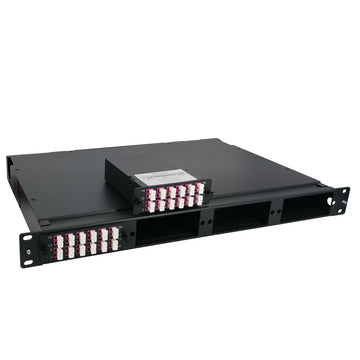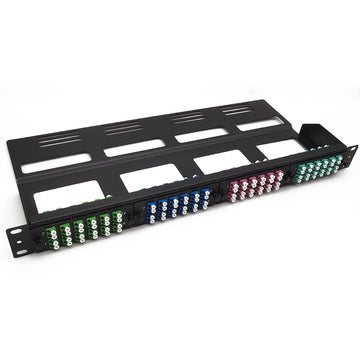Twisted Pair Cables Cabling for Ethernet Network
Twisted pair copper cabling is the most ubiquitous for Ethernet network and telephone installations. But how much do you know about twisted pair cable? What makes it different from other cables and how many types of twisted cables are there?
What is Twisted Pair Cables?
Twisted pair cabling consists of two conductors of a single circuit, twisted together. By twisting the wires, some part of the noise signals goes in one direction (sending) while the other part goes in the opposite direction (receiving). This effectively cancels out interference and crosstalk from external sources. In simple words, compared to a single conductor or an untwisted balanced pair, a twisted pair reduces electromagnetic radiation from the pair and crosstalk between neighboring pairs and improves rejection of external electromagnetic interference. According to EIA/TIA-568 standard, twisted pair cables are classified into different categories such as Cat5e, Cat6, Cat7, Cat8 cables based on their electrical characteristics.
Ethernet copper twisted pair cables are broadly classified in to two. Unshielded Twisted Pair (UTP) Cable and Shielded Twisted Pair (STP) cable. Shielded Twisted Pair Cable (STP) uses different shielding techniques to limit any signal from the cable or wire to escape and to reduce electromagnetic interference from outside environment. For instance, factors like electromagnetic radiation from unshielded UTP cables and crosstalk from other neighboring pairs are significantly reduced, making twisted pair cable an ideal solution for numerous connection and data transfer needs.
Types of Twisted Pair Cables
For additional noise immunity, twisted pair cabling may be shielded. Cable with shielding is known as shielded twisted pair (or STP cable) and without as unshielded twisted pair (or UTP cable). Below content explains their differences in detail.
Unshielded Twisted Pair Cable(UTP):
Unshielded twisted pair (UTP) an unshielded twisted pair cable used in computer and telecommunications mediums. Its frequency range is suitable for transmitting both data and voice via a UTP cable. UTP do not rely on physical shielding to block interference and it relies instead on balancing and filtering techniques using media filters, baluns or both.
Unshielded means no additional shielding like meshes or aluminum foil are used. Because of this, unshielded Ethernet cables, also called unshielded twisted pair (UTP) cable are lighter and cheaper. These Ethernet cables are designed to cancel EMI with the way the pairs are twisted inside the cables. Compared with the shielded cables, unshielded cables provide much less protection. These cables performances are often degraded when EMI is present.

Shielded Twisted Pair Cable(STP):
Shielded Twisted Pair (STP) cables are generally used for Ethernet cabling where there are heavy electrical equipment used and large number of electrical cables are there, which can cause electromagnetic interference. Example: Factories. A STP is a type of twisted pair cable that contains an extra wrapping foil or copper braid jacket to protect the cable from defects like cuts, losing bandwidth, noise, and signal to the interference. It is a cable that is usually used underground, and therefore it is costly than UTP.
STP cables work by attracting interference to the shield, then running it off into a grounded cable. According to different shieldings, STP cables can be divided into several types:
- F/UTP type of Shielded Twisted Pair (STP) cables
- S/UTP type of Shielded Twisted Pair (STP) cables
- SF/UTP type of Shielded Twisted Pair (STP) cables
- S/FTP type of Shielded Twisted Pair (STP) cables
- F/FTP type of Shielded Twisted Pair (STP) cables
- U/FTP type of Shielded Twisted Pair (STP) cables
Following codes are widely used and adopted by TIA/EIA to represent different types of Shielded Twisted Pair (STP) cables.
| Code | Meaning |
| TP | Twisted Pair |
| U | Unshielded |
| F | Foil Shielded |
| S | Braid Shielded |
The shielding in Shielded Twisted Pair (STP) cables can reduce electromagnetic interference in two ways.
- Shielding can reflect the electromagnetic interference back.
- We can ground the shielding so that shielding can pick the electromagnetic interference from surrounding environment and pass it to the ground, through a Drain Wire.
Twisted Pair Cables Which Should I Choose?
STP and UTP cable differ in design and manufacture. But their purpose should be the same — to provide reliable connectivity of electronic equipment. In theory, both types of cable should do this equally well.
As for shielded vs unshielded Ethernet cable, the best choice should largely depend on where you plan to install the cables. As mentioned above, STP and UTP cables are widely used in different fields due to EMI interference requirement. Airports, medical centres and factories often benefit from STP cabling, because these places need to process numerous machines that produce considerable amounts of interference. On the other hand, for home and office use, it’s wise to choose UTP cables.
LightOptics products of high-speed cables is designed to out-perform parallel pair designs in bend radius, flexibility, reliability, time delay skew and mode conversion. Using a twisted shielded pair design, LightOptics products allow for a tighter bend radius for improved cable management in high-density systems. The twisted pair design also helps dramatically reduce termination issues associated with pistoning and the cables are inherently balanced and provide better mechanical reliability than current parallel-pair products.
Therefore, as for these STP or UTP Ethernet cables, it should be determined by the intended application. If you’re still not sure what type of cabling you need, please contact us via sales@lightoptics.co.uk for expert advice.












